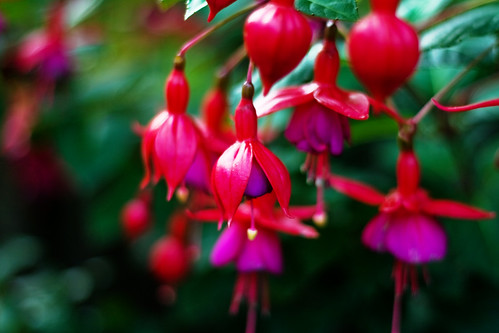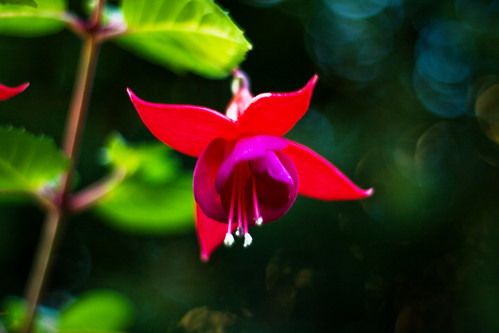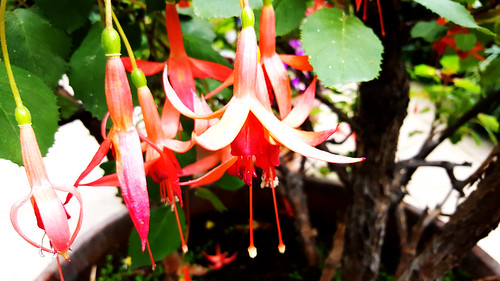Few flowers brighten a garden quite the same way as the fuchsia. The beautiful pendants come in a range of colours, though my favourites are the deep, dark pink variety.
While I’ve often focused on toxic flowers such as foxgloves or daffodils, this humble plant comes with a few of its own folktales.

Some believe it’s unlucky to take the flowers indoors. Emily at GrowEatGift notes that the fuchsia also provides fairies with a favourite hiding place (2016). Which could explain why it’s unlucky to bring them indoors.
But the fuchsia is also a favourite of the hummingbird. I doubt we get many of them in Newcastle, but it’s nice to leave nectar-producing flowers where creatures can get at them.
Where is the fuchsia from?
It actually comes from South America, having been brought to Britain in 1788. The western world first discovered the fuchsia in 1695. A French Catholic priest named Charles Plumier discovered a strain in the Dominican Republic.
Also known as Lady’s Eardrops, the fuchsia family contains more than 100 species. It’s named after Leonhart Fuchs. This 16th-century German herbalist was also a doctor and a botanical illustrator.
In western Ireland, it’s called ‘deora De’, which translates as God’s Teardrops. It’s an incredibly prolific flower throughout Ireland.
The fuchsia found its way to the Isle of Man in 1820 and it’s worn on Tynwald (Manx National) Day on 5 July. It’s even their preferred floral emblem (the alternative being ragwort).
So come on. What’s the folklore?
The fuchsia doesn’t have the same degree of folklore as a plant like the bluebell. Plants like rowan and henbane end up surrounded by folklore through their links to witchcraft. Meanwhile, the fuchsia didn’t appear in Britain until the late 18th century.
Yet the Fuchsia boliviana was popular among the Incas of Bolivia and Peru (Margelony 2020). R. Theo Margelony explains that the plant may have had “ritualistic, religious and political significance” but ultimately shouldn’t be confused with Cantua buxiolia, the Incas’ sacred flower (2020). The Fuchsia boliviana can be found on the paths that lead to Machu Picchu.
But it does have some European tales associated with it (hence this post).
Some believe the fuchsia represents amiability, anxiety, ‘humble love’ and ‘confiding love’. I’ll be honest – I’m not sure what the last one even means.
But Ellen Dugan notes that, despite its beauty, the fuchsia “symbolizes a warning” (2012: 128). It’s best planted in a hanging basket and enchanted to help protect your home.
Claire Nahmad expands on this; apparently, the warning means “Take heed, your beloved is false” (1994: 40).
According to Plant-lore.com, it was common in Ireland and Scotland to make a ‘lady’ or ‘fairy’ from the flowers. The petals form a skirt and you take out all but two of the stamens, leaving ‘legs’ (2021). It’s easier to see her as a ballerina in the photo below.

Another popular pastime was cutting off the top and sucking out the nectar. Bit painful if you’ve just turned her into a ballerina. Apparently, the berries are also edible so it makes a change for me to feature a plant that won’t kill you. That’s one of the reasons why the Incas cultivated the plant (Margelony 2020).
According to the Encyclopedia of Superstitions, Folklore, and the Occult Sciences of the World, the fuchsia even has Biblical connections. They relate an ancient story that the fuchsia sprang from the blood of Christ at the foot of the cross. Its pendants dangle because it hangs “its head from sorrow” (2003: 124).
Any bride who offered the fuchsia as an offering on her wedding day would enjoy bounteous blessings. She could also wear them in her hair for the same result.

Anything else?
Sadly, that’s all I’ve been able to find! Most of the articles detail the history of the plant or the scope of its many varieties. They do make a wonderful addition to any garden, and they add a brilliant pop of colour to borders and hanging baskets.
If anyone knows any other folk tales or lore associated with the fuchsia, please drop it in the comments below so I can expand the post.
Any Amazon links in this post are affiliate links. If you choose to purchase these books after following these links, I’ll make a few pennies, but any money raised goes towards website hosting fees. Thanks!
References
Dugan, Ellen (2012), Cottage Witchery: Natural Magick for Hearth and Home, Woodbury, MN: Llewellyn.
Emily (2016), ‘Folklore Thursday: Flower Fairies’, Grow Eat Gift, https://groweatgift.com/2016/08/11/folklore-thursday-flower-fairies/.
Margelony, R. Theo (2020), ‘The Inca and the Fuchsia’, The Fuchsia+Blog, https://fuchsietum.com/blog/files/Inca-and-the-fuchsia.php.
Nahmad, Claire (1994), Garden Spells: The Magic of Herbs, Trees and Flowers, London: Pavilion Books (aff link).
Plant-Lore (2021), ‘Fuchsia’, Plant-Lore.com, https://www.plant-lore.com/fuchsia/.
Nutty about folklore and want more?
Add your email below and get these posts in your inbox every week.
You'll also get my 5-step guide to protecting your home using folklore!







I have a photo of fuchsias in my garden, I’ll grab it and post it to twitter! Love this post. Thanks, Icy. I wonder if there’s folklore about lavender…? 🙂
My sister and I used to make fairies out of them and tell stories with fuchsia flowers when we were little! Mam wasn’t so pleased when she found we’d left a big gap in the bush’s flower coverage though…
Great post, as always! I didn’t know about the Biblical connection, always good to find a new fun flower folkstory!
You’re welcome!
This was a lovely post. Thanks for this, Icy. 🙂
When we were kids, we were told if you pull the longest stamen out and the end is white, you’ll get a wish granted by the fairies. If you lick the white bit and it’s sweet, it will be granted soon. N Yorkshire
Oh I hadn’t heard that one, thank you!